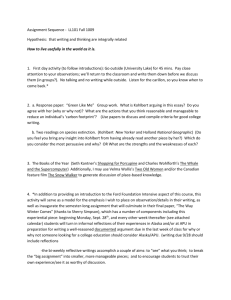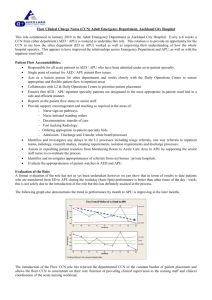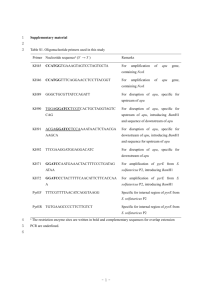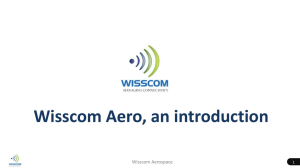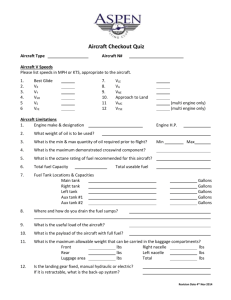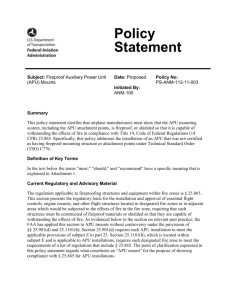2011 – 2012 TGS Study Guide Technical Ground School Study
advertisement
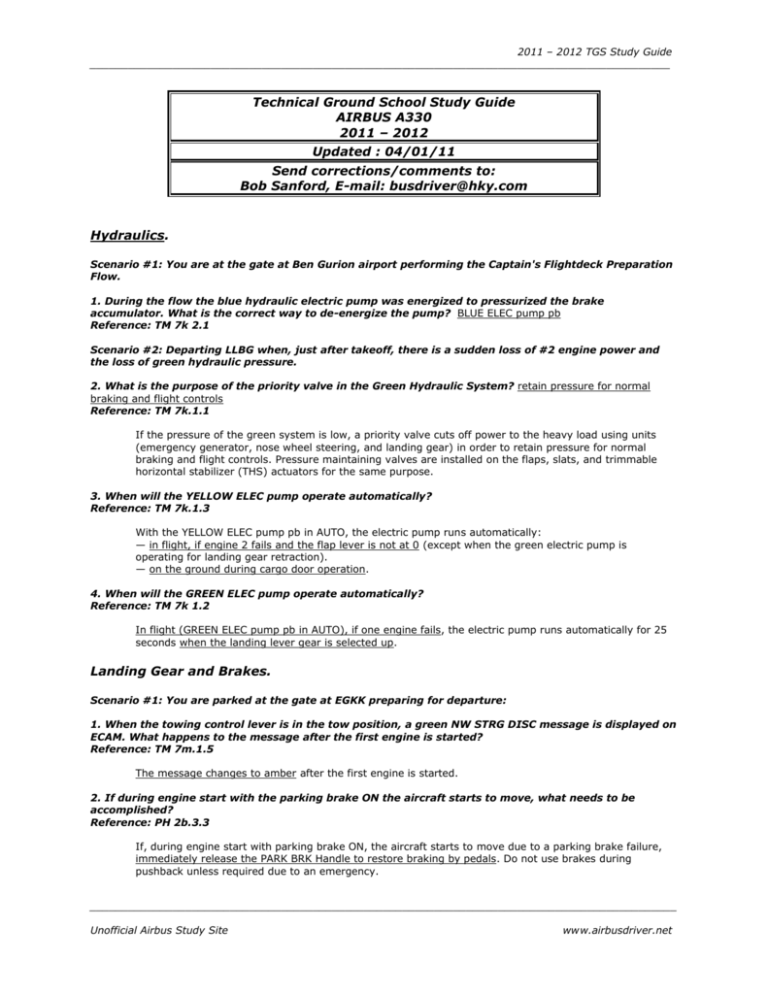
2011 – 2012 TGS Study Guide ___________________________________________________________________________________________ Technical Ground School Study Guide AIRBUS A330 2011 – 2012 Updated : 04/01/11 Send corrections/comments to: Bob Sanford, E-mail: busdriver@hky.com Hydraulics. Scenario #1: You are at the gate at Ben Gurion airport performing the Captain's Flightdeck Preparation Flow. 1. During the flow the blue hydraulic electric pump was energized to pressurized the brake accumulator. What is the correct way to de-energize the pump? BLUE ELEC pump pb Reference: TM 7k 2.1 Scenario #2: Departing LLBG when, just after takeoff, there is a sudden loss of #2 engine power and the loss of green hydraulic pressure. 2. What is the purpose of the priority valve in the Green Hydraulic System? retain pressure for normal braking and flight controls Reference: TM 7k.1.1 If the pressure of the green system is low, a priority valve cuts off power to the heavy load using units (emergency generator, nose wheel steering, and landing gear) in order to retain pressure for normal braking and flight controls. Pressure maintaining valves are installed on the flaps, slats, and trimmable horizontal stabilizer (THS) actuators for the same purpose. 3. When will the YELLOW ELEC pump operate automatically? Reference: TM 7k.1.3 With the YELLOW ELEC pump pb in AUTO, the electric pump runs automatically: — in flight, if engine 2 fails and the flap lever is not at 0 (except when the green electric pump is operating for landing gear retraction). — on the ground during cargo door operation. 4. When will the GREEN ELEC pump operate automatically? Reference: TM 7k 1.2 In flight (GREEN ELEC pump pb in AUTO), if one engine fails, the electric pump runs automatically for 25 seconds when the landing lever gear is selected up. Landing Gear and Brakes. Scenario #1: You are parked at the gate at EGKK preparing for departure: 1. When the towing control lever is in the tow position, a green NW STRG DISC message is displayed on ECAM. What happens to the message after the first engine is started? Reference: TM 7m.1.5 The message changes to amber after the first engine is started. 2. If during engine start with the parking brake ON the aircraft starts to move, what needs to be accomplished? Reference: PH 2b.3.3 If, during engine start with parking brake ON, the aircraft starts to move due to a parking brake failure, immediately release the PARK BRK Handle to restore braking by pedals. Do not use brakes during pushback unless required due to an emergency. ____________________________________________________________________________________________ Unofficial Airbus Study Site www.airbusdriver.net 2011 – 2012 TGS Study Guide ___________________________________________________________________________________________ Scenario #1 continued : Now cleared to "Line up and Wait runway 26L" 3. At what speed during takeoff, does the rudder pedal nose wheel steering angle begin to be reduced? Reference: TM 7m.1.5 When using the hand wheels, nose wheel steering angle is reduced above 10 knots ground speed. As speed increases, the angle decreases progressively to 0° at 100 knots. When using the rudder pedals during takeoff, nose wheel steering angle is reduced above 100 knots ground speed. As speed increases, the angle decreases progressively to 0° at 150 knots. When using the rudder pedals during landing, rudder pedal steering is not available until below 100 knots, where the angle increases progressively to full authority at 40 knots. 4. During a rejected takeoff, with MAX selected, when is maximum pressure applied to the brakes? Reference: TM 7m.2.2 If the pilot aborts the takeoff, maximum pressure goes to the brakes as soon as the system generates the ground spoiler deployment order. Scenario #2: You being vectored for ILS 9R into KPHL, visibility is ½ mile in snow: 5. How many Landing Gear Control and Interface Units (LGCIU) are installed and what is their function? Reference: TM 7m.1.2 Two LGCIUs provide sequencing, operation, monitoring, and indications for the landing gear. 6. When does the Autobrake system initially apply the brakes during landing using the LO setting? 1 second after the ground spoilers deploy The MED setting? starting at ground spoilers deployment Reference: TM 7m.2.2 MED or LO mode is normally selected for landing. • LO mode sends progressive pressure to the brakes 1 second after the ground spoilers deploy in order to decelerate the aircraft at 5.9 ft/s2. • MED mode sends progressive pressure to the brakes starting at ground spoilers deployment in order to decelerate the aircraft at 9.8 ft/s2. 7. Prior to landing on the snow covered runway you selected autobrakes LO, now during the roll out the DECEL light does not illuminate, does this mean the autobrakes are not working? No Reference: TM 7m.2.2 On slippery runways, the predetermined deceleration may not be reached due to antiskid operation. In this case DECEL light will not illuminate. This does not mean that autobrake is not working. 8. Is the anti-skid system operational with Blue hydraulic pressure supplied to alternate brakes from the engine driven pump? Yes Reference: TM 7m.1.8 / 7m.1.10 The antiskid may or may not be available with alternate brakes. During alternate braking, the antiskid system becomes inoperative: — with electrical power failure, — with BSCU failure, — if the A/SKID & N/W STRG switch is selected OFF, or — if the brakes are supplied by the blue accumulators only. 9. With loss of the anti-skid system, how does the pilot regulate brake pressure to avoid wheel locking? Reference: QRH page 80 / TM 7m.1.10 If the antiskid is not available, braking is achieved by the pedals, and brake pressure must be limited by monitoring the blue system brake and accumulator pressure indicator to prevent wheel locking. • Braking: B ACCU PRESS only, (7 applications) • Max BRK PR 1000 psi (Anti-Skid not operative) Flight Controls. Scenario #1: ATC cleared you for the approach on a tight downwind leg. They want you to turn in as soon as possible. ____________________________________________________________________________________________ Unofficial Airbus Study Site www.airbusdriver.net 2011 – 2012 TGS Study Guide ___________________________________________________________________________________________ Everything with the aircraft is currently normal. 1. What happens in normal law when a 45-degree bank is held and then sidestick pressure is released? Reference: TM 7h 1.5 Bank angles in excess of 33° require constant sidestick input. If the input is released, the aircraft returns to and maintains 33° of bank. 2. Explain, in general terms, High Speed protection. Reference: TM 7h 1.5 High speed protection. Prevents exceeding VMO or MMO by introducing a pitch up load factor demand. The pilot cannot override the pitch up command. 3. With the high angle of attack protection in mind, to what speed will the airplane slow to if the sidestick is held full aft? Reference: TM 7h .1.5 When the angle of attack exceeds ⍺ prot, elevator control switches to ⍺ protection mode in which angle of attack is proportional to sidestick deflection. However ⍺ max will not be exceeded even if the pilot applies full aft deflection. 4. When does an amber SPD BRK memo appears? Reference: TM 7h 1.3 The memo turns amber if the speedbrakes are extended when the thrust is above idle 5. What happens to extended speed brakes when FLAPS FULL is selected on the A330-300? Reference: TM 7h 1.3 Speedbrake extension is inhibited if: — Maneuver Load Alleviation (MLA) is activated — angle of attack protection is active — low speed stability is active — flaps are in configuration FULL (A330-300) — at least one thrust lever is above MCT — Alpha floor activation If an inhibiting condition occurs, the speedbrakes retract automatically. To regain control of the speedbrakes, the inhibiting condition must be corrected and the SPEED BRAKE lever must be moved to the RET position for five seconds. 6. Describe the Flap Load Relief System (FLRS). Reference: TM 7h.1.4 If an overspeed condition exists, the system automatically retracts (or prevents extension of) the flaps (available only in CONF 2, 3, or FULL). Flaps will automatically retract to the next flap setting when speed exceeds VFE + 2.5 knots. Flaps will not extend (or re-extend) to the selected position, until below VFE – 2.5 knots. In CONF 2, auto retraction results in CONF 1*. In CONF 3, auto retraction results in CONF 2*. Scenario #1 continued: After experiencing multiple failures of redundant systems… 7. What will the aircraft do in alternate law with speed stabilities, if the VMO or MMO is exceeded? Reference: TM 7h 1.5 A nose-up command is introduced any time the airplane exceeds VMO/MMO to keep the speed from increasing further. This command can be overridden by sidestick input. 8. Is automatic pitch trim available in alternate law? Yes Reference: TM 7h.1.5 In alternate law, automatic pitch trim is available Autoflight. ____________________________________________________________________________________________ Unofficial Airbus Study Site www.airbusdriver.net 2011 – 2012 TGS Study Guide ___________________________________________________________________________________________ Scenario #1: Everything with the aircraft is again currently normal. ATC cleared you for the approach on a tight downwind leg. You are a little fast and they want you to turn in as soon as possible. 1. What display confirms that the ILS is ARMED for the approach? Reference: TM 7d.2.2 and PH 2f.5 The flight mode annunciator (FMA), located just above the primary flight displays; GS and LOC annunciate blue on FMA 2. Excluding system failures, name some of the five ways the autopilot will disengage? Reference: TM 7d.1.5 The autopilot(s) will disengage if one of the engagement criteria is lost, or: — The takeover switch or the corresponding AP switch is pressed — The sidestick is moved beyond the load threshold (Disengagement through rudder pedals is only active on the ground.) — The other autopilot is engaged, except when LOC G/S modes are armed or engaged, or ROLL OUT and GA modes are engaged — Both thrust levers are set to TOGA detent on the ground (prevents takeoff with autopilot engaged following a touch and go.) — Reaching DA – 50’ with APPR engaged on a NON-ILS (RNAV) approach The autopilot(s) will also disengage in normal law when: — high speed protection is activated — — bank angle exceeds 45° or pitch attitude exceeds 25° up or down 3. What is Alpha Floor? Reference: TM 7d.1.11 A protection that commands TOGA thrust regardless of the positions of the thrust levers. This protection is available from lift-off to 100 feet RA on approach. ALPHA FLOOR calls up the following indications: — “A FLOOR” in green surrounded by a flashing amber box on the FMA and in amber on the engine warning tions are met — floor conditions. TOGA thrust is frozen and thrust lever movement will have no effect. ALPHA FLOOR is inhibited: — in case of engine failure with flaps extended — in case of engine failure with derated TO selected — below 100' during landing — above M.53 — ALPHA FLOOR protection is lost in the event of A/THR failure 4. How is TOGA LK canceled? Reference: TM 7d 1.11 To cancel ALPHA FLOOR or TOGA LK thrust, disconnect the autothrust 5. What is Thrust Lock? Reference: TM 7d 1.11 The thrust lock function prevents thrust variations when the autothrust system fails and disengages. The thrust lock function is activated when the thrust levers are in the CL detent (MCT detent with one engine out) and — the pilot disengages A/THR by pushing the A/THR pushbutton on the FCU, or — the A/THR disconnects due to a failure The thrust is locked or frozen at its level prior to disconnection. Moving the thrust levers out of the CL or MCT detent suppresses the thrust lock and allows manual control by means of the thrust levers. 6. How is the Go Around mode engaged? Reference: TM 7d 1.3 ____________________________________________________________________________________________ Unofficial Airbus Study Site www.airbusdriver.net 2011 – 2012 TGS Study Guide ___________________________________________________________________________________________ It engages when the thrust levers are placed in the TOGA detent, the slats/flaps lever is at least in position 1, and: — aircraft is airborne, or — aircraft has been on the ground for less than 30 seconds 7. What is SRS and when, other than take off, is it active? Reference: TM 7d.1.3 This vertical mode controls pitch to maintain a speed defined by SRS guidance (provided V2 is inserted in the MCDU PERF TO page, the slats are extended, and the aircraft is on the ground). It engages automatically when the thrust levers are set to TOGA or MCT/FLX detent. It disengages manually when another vertical mode is engaged or a speed is selected while in SRS mode. It automatically disengages when the aircraft reaches acceleration altitude or an FCU selected altitude. APU. Scenario #1: It is winter in KCLT. You are at the gate approximately 15 prior to departure. Route verification is completed. You have decided to start the APU. 1. After depressing the APU MASTER pb, the START pb is pressed. At this time the START pb illuminates blue. What does that mean? Reference: TM 7c.2.1 Blue ON light illuminates. — When the flap is completely open, the APU starter is energized. — When N = 7%, the ignition is turned on. — When N = 50%, the APU starter is de-energized, and ignition is turned off. — When N = 95%, • The ON light on the START pb goes out • The AVAIL light illuminates green. • The APU may now supply bleed air and electrical power to the aircraft systems. — 10 seconds later, the APU page disappears from the ECAM display. 2. If external A and B is powering the aircraft during APU start, when the green AVAIL light illuminates on the APU START pushbutton, what is the source of ships electrical power? APU generator for AC BUS 1, and EXT A for AC BUS 2 Reference: TM 7f.1.2 Normal priority for supplying electrical power to each of the two main AC buses is: 1. Corresponding engine generator 2. APU generator or external power A (If both are connected, the APU generator has priority for AC BUS 1, and EXT A has priority for AC BUS 2.) 3. External power B (If both EXT A and EXT B are connected, EXT B has priority for AC BUS 1 and EXT A has priority for AC BUS 2.) 4. Opposite engine generator 3. What is indicated when the APU EGT indication is displayed in amber or red? Reference: TM 7c.2.2 (Note – can’t find an answer to this in the current TM) Becomes red when EGT > RED EGT LIM* associated with automatic shut down It pulses when the ECB detects an advisory 4. May the APU be operated on the ground without pilot supervision? Yes Reference: TM 7c.1.7 The APU may be operated on the ground without supervision 5. Can the APU be shut down from outside the aircraft? Yes Reference: TM 7c ____________________________________________________________________________________________ Unofficial Airbus Study Site www.airbusdriver.net 2011 – 2012 TGS Study Guide ___________________________________________________________________________________________ Scenario #1 continued: You have climbed through FL 300… 6. Will the APU bleed valve close automatically during climb? Will it reopen during descent? Reference: TM 7c.1.4 It is automatically closed climbing through 25,000’, and allowed to re-open descending through 23,000’ Electrical. Scenario #1: You have arrived at an unpowered aircraft that has just come from maintenance. You are preparing to do the preflight operations and are in the cockpit. During the Safety and Power On checklist: 1. You notice the battery voltage is below minimum. Can the batteries be fully depleted? No Reference: TM 7f.1.4 Battery automatic cut-off logic prevents complete discharge of the battery when the aircraft is on the ground and unpowered. 2. When are the batteries connected to the DC BAT BUS? Reference: TM 7f.1.4 / 7f.2.1 With the BAT 1/BAT 2 pb(s) in AUTO, the BCL connects its respective battery to the DC BAT bus when charging is required. — The batteries are connected to the DC BAT BUS in the following cases: • Battery voltage below 26.5 volt (battery charge). The charging cycle ends when battery charge current goes below 4 ampers (for 10 seconds on ground, 30 minutes in flight). • On the ground (with speed below 50 knots), when batteries only are supplying the aircraft. • In flight DC generation lost (limited to 7 seconds). Scenario #1 continued: The APU has been started and prior to disconnecting external power: 3. If the blue ON light is present in the EXT PWR A pushbutton and a green AVAIL light on the APU START pb, what is the source of electrical power (with engines shut down)? Reference: TM 7f.1.2 / 7f.2.1 APU generator for AC BUS 1, and EXT A for AC BUS 2 Scenario #2: You are at cruise at FL 370. The APU is MEL'd. Everything is normal until an IDG fault light illuminates: 4. An IDG Fault light illuminates amber for what reason(s): Reference: TM 7f.2.1 Illuminates amber, and ECAM caution comes on, if: — IDG oil outlet overheats (above 185°C), or — IDG oil pressure is low. Inhibited at low engine speed: N3 below 52% (A330-200) or N2 below 14% (A330-300) ____________________________________________________________________________________________ Unofficial Airbus Study Site www.airbusdriver.net 2011 – 2012 TGS Study Guide ___________________________________________________________________________________________ Scenario #2 continued: ECAM required the disconnect of the #1 IDG and was performed, then a short time later the #2 GEN light illuminates. 5. What automatic function is triggered with the loss of both main AC buses? Reference: TM 7f.1.7 If both main AC buses lose electrical power, the emergency generator, (powered by the green hydraulic system), is automatically connected to the aircraft electrical system 6. In flight, automatic Emergency Generator deactivation only occurs when? Reference: TM 7f.1.7 During RAT deployment and emergency generator coupling, the batteries supply power to these buses. If powered by the RAT only, the EMER GEN is inhibited when slats are extended, but can be reactivated in flight after flap retraction, through the EMER ELEC PWR MAN ON pb. Scenario #2 continued: You were directed by the ECAM STATUS page to select the LAND RECOVERY pb ON while on final approach: 7. In general what happens when you press the LAND RECOVERY push-button? Reference: TM 7f.1.8 / 7f.2.5 The LAND RECOVERY pb allows the AC LAND RCVRY and the DC LAND RCVRY buses to be regained after they were shed due to emergency generator operation. If the emergency generator is powered by an engine driven pump, the SHED LAND RCVRY bus will also be regained. The following equipment is restored: — LGCIU 1 — SFCC 1 (flap channel is not recovered if the emergency generator is powered by the RAT or on batteries) — ILS 1 — BSCU channel 1 (not recovered if the emergency generator is powered by the RAT or on batteries) — LH windshield anti-ice (not recovered if the emergency generator is powered by the RAT or on batteries) — LH landing light (not recovered if the emergency generator is powered by the RAT or on batteries) The remaining fuel pump (if any) is lost Powerplant. Scenario #1: It is summertime in Madrid, with a high density altitude reported. You are at the gate prior to engine start. 1. What is the minimum oil quantity for dispatch? Reference: PH 2a.3.4 / PH 2a.7.3 / PH2b.3.3 • A330-200: 16 quarts • A330-300: 18 quarts 2. Name some reasons that a manual start may be required? Reference: PH 4.8.5 Manual engine starting is recommended in the following cases: • After aborting a start because of: — STALL — EGT OVERLIMIT — LOW START AIR PRESS • When expecting a start abort because of: — Degraded bleed performance due to a hot condition or at a high altitude airfield. — An engine with a reduced EGT margin in a hot condition or at a high altitude airfield — Marginal performance of external pneumatic power. 3. If the #1 ENG MAN START pushbutton is depressed, will the engine begin to motor? No Reference: TM 7p.2.3 ____________________________________________________________________________________________ Unofficial Airbus Study Site www.airbusdriver.net 2011 – 2012 TGS Study Guide ___________________________________________________________________________________________ The start valve opens if the ENG START selector is set to CRANK or IGN/START 4. During a manual start of the #1 engine, does the ENG MAN START pushbutton have to be depressed to close the start valve? No Reference: TM 7p.2.3 The start valve closes automatically when N2 is between 43 and 48%. Scenario #1 continued: During taxi-out there appears to be an aircraft induced split in the engine power settings: 5. Keep Out Zone logic prevents fan instability in what EPR range on the A330-200 only? Reference: TM 7p.1.3 To prevent fan instability, this logic avoids stabilized engine operation between the 1.16 to 1.28 EPR range (in N1 rated mode, the keep-out zone depends on the ambient conditions), when on the ground with an aircraft speed below 80 knots. Scenario #1 continued: Climb out required you fly through heavy rain: 6. With the ENGINE MODE switch in NORM, will ignition be provided if an engine flameout is detected in flight? Yes Reference: TM 7p.2.2 NORM: Continuous ignition (A + B) is selected when the engine is running and one of the following conditions is met: — a flameout is detected, — in flight engine surge is detected — approach idle is selected, or — takeoff mode is selected (TOGA or FLX). 7. Is it possible to over boost the engine in the unrated N1 mode? Yes Reference: TM 7p.1.3 The N1 rating limit, N1 TLA, and N1 max indications on the ECAM E/WD are lost in this condition Fire Protection. Scenario #1: At the gate, external power is not available, APU is supplying electrical power. You are performing the exterior inspection: 1. What exterior fuselage indication shows the APU agent has not discharged due to bottle overpressure? Reference: TM 7g.2.2 A red disk, placed at the exterior rear of the fuselage, indicates the agent is not discharged overboard due to bottle overpressure 2. If an APU fire is detected by the aircraft while on the ground, what will automatically occur? Reference: TM 7g.1.3 On the ground, detection of an APU fire causes automatic APU shutdown and extinguisher discharge. In flight, there is no automatic APU shutdown and the extinguisher must be manually discharged. Scenario #1 continued: During the flightdeck preparation flow: 3. What are the indications of a successful engine fire test? Reference: TM 7g.2.1 / PH 2a.7.3 • • • • • ENG 1 and 2 FIRE Pushbuttons illuminated SQUIB and DISCH lights illuminated MASTER WARN lights illuminated CRC ENG 1 and 2 FIRE warning on E/WD ____________________________________________________________________________________________ Unofficial Airbus Study Site www.airbusdriver.net 2011 – 2012 TGS Study Guide ___________________________________________________________________________________________ • ENGINE page on SD • FIRE lights (on ENG panel) illuminated When the flight crew presses it: — A continuous repetitive chime sounds. — The MASTER WARN lights flash. — ENG FIRE warning appears on ECAM. On the FIRE panel: — The ENG FIRE pb illuminates red. — The SQUIB lights illuminate white if discharge supplies are available. The DISCH illuminates amber. On the ENG panel (pedestal) the FIRE lights illuminate red. 4. What does an illuminated amber DISCH light on the ENGINE FIRE AGENT or APU AGENT pushbutton indicate? Reference: TM 7g.2.1 DISCH illuminates amber when its fire extinguisher bottle has lost pressure. 5. What fire protection do the lavatory waste bins have? Reference: TM 7g.1.5 Each lavatory waste bin is protected by a self-contained extinguisher which discharges automatically in case of fire. Scenario #2: During cruise flight you get a MASTER WARNING light, CRC, ECAM message and a CARGO SMOKE light illumination. 6. What action arms the cargo fire extinguisher squibs? Reference: TM 7g.1.4 (Note – can’t find an answer to this in the current TM) Armed as long as the HOT BATTERY BUS is powered. The agents are both activated with single press of the applicable AGENT pb. 7. Do both cargo compartment bottles discharge at the same rate? No Reference: TM 7g.1.4 Bottle 1 discharges immediately, all at once. The discharge of cartridge bottle 2 comprises a flow metering system, so the fire extinguishing agent is discharged slowly into the compartment to ensure sufficient agent concentration for 240 minutes. Fuel. Scenario #1: You are on the flight deck prior to departure. Fuelers are approaching the aircraft: 1. Which electric power sources can be used to refuel? Reference: TM 7j.1.9 External power, the APU, or battery power can be used for refueling. Scenario #1 continued: While in cruise flight: 2. What is the normal fuel feed sequencing? Reference: TM 7j.1.10 Fuel is always fed to the engines from the inner tanks. The tanks empty in the following sequence: A330-200. 1. center tank fuel transfers to the inner tanks. 2. each inner tank empties down to 8,830 lbs. 3. trim tank fuel transfers into the inner tanks (this may occur earlier for CG control) 4. each inner tank empties down to 7,720 lbs. 5. outer tank fuel transfers to the inner tanks. A330-300. 1. inner tanks — down to about 8,800 lbs each 2. trim tank fuel transfers into the inner tanks (this may occur earlier for CG control) ____________________________________________________________________________________________ Unofficial Airbus Study Site www.airbusdriver.net 2011 – 2012 TGS Study Guide ___________________________________________________________________________________________ 3. inner tanks — down to about 7,700 lbs each 4. outer tanks fuel transfers into inner tanks. 3. Is it possible to balance fuel if the crossfeed valve is failed closed? Yes Reference: QRH page 73 If the WING X FEED valve is failed closed: (a) FUEL OUTR TK XFR.........................................................ON (b) Bank angle..................................3° wing down on lighter side [Fuel transfer only occurs if the bank angle is at or above, 2° to 3°. Modulate the fuel imbalance through bank angle.] (c) Rudder Trim...................................................................... Use [Use rudder trim to get constant course and neutral stick.] Scenario #1 continued: Still in cruise, you get a MASTER CAUTION light and ECAM displays FUEL T TANK XFER FAULT. You select "T TANK MODE …. FWD" 4. In the event of a trim tank forward transfer pump failure, do not select the trim tank forward when the pitch attitude is above 3°. Why? Reference: PH 1.6.4 In the event of a trim tank forward transfer pump failure, do not select the trim tank forward when the pitch attitude is above 3 degrees to avoid inadvertent fuel aft transfer. 5. When manually transferring fuel forward, what is the concern for the crew with regards to the APU? Reference: TM 7j.1.10 TM 7j.2.1 The OPEN position of the switch (T TANK FEED) opens all relevant valves, and maintains them open for 3 minutes after the trim tank is emptied to allow the transfer line to drain. APU fuel supply is not possible when the transfer line is empty. Center tank overflow must be manually prevented. 6. What will cause illumination of the OUTR TANK XFR FAULT light? Reference: TM 7j.2.1 The amber light and the ECAM caution come on when : — the inner tank low level is reached and the associated outer tank is not empty, or — the FCMC is unable to carry out the transfer to inner tanks, or — the FUEL LO TEMP warning is triggered. ____________________________________________________________________________________________ Unofficial Airbus Study Site www.airbusdriver.net
